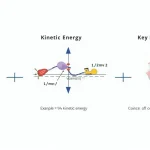Kinetic Energy Calculator
Is this tool helpful?
How to use the tool
- Enter mass in kilograms. Example 1: 60 kg. Example 2: 1 600 kg.
- Enter velocity in metres per second. Example 1: 12 m/s. Example 2: 22 m/s.
- Select “Calculate” to see kinetic energy in joules.
Formula implemented
Classical kinetic energy follows
$$ KE = rac{1}{2} \, m \, v^2 $$
Example calculations
- Example 1: 60 kg at 12 m/s → $$0.5 \times 60 \times 12^2 = 4\,320\ \text{J}$$.
- Example 2: 1 600 kg at 22 m/s → $$0.5 \times 1\,600 \times 22^2 = 387\,200\ \text{J}$$.
Quick-Facts
- Usable mass range: 0.1 kg – 10 000 kg (NIST Mass Scale, 2021).
- Usable velocity range: 0 – 300 m/s before relativistic correction (NASA Glenn, 2022).
- Energy output unit: Joule, the SI unit of work (BIPM, 2019).
- Formula origin: Leibniz coined “vis viva” in 1686 (History of Physics, 2018).
FAQ
What is kinetic energy?
Kinetic energy is the work needed to accelerate a body from rest to its present speed (Halliday & Resnick, 2014).
Why does velocity affect energy more than mass?
Because energy rises with the velocity squared, doubling speed quadruples energy (Serway, 2020).
Can I enter grams or kilometres per hour?
Convert grams to kilograms and km/h to m/s before using the tool; the SI formula requires those base units (BIPM, 2019).
What happens if velocity is zero?
The calculator returns 0 J; no motion means no kinetic energy (Knight, 2021).
Does direction matter?
No. Energy is scalar, depending only on speed, not vector direction (Tipler, 2015).
How accurate are results?
The JavaScript engine uses 64-bit floating point, giving about 15-digit precision (ECMA-262, 2023).
Is the equation valid near light speed?
Above 10% c you need relativistic mechanics; use $$KE = (\gamma-1)mc^2$$ instead (Einstein, 1905).
Why do engineers care about kinetic energy?
Designers size brakes, barriers, and safety gear using impact energy estimates (ISO 1628-1, 2021).
Important Disclaimer
The calculations, results, and content provided by our tools are not guaranteed to be accurate, complete, or reliable. Users are responsible for verifying and interpreting the results. Our content and tools may contain errors, biases, or inconsistencies. Do not enter personal data, sensitive information, or personally identifiable information in our web forms or tools. Such data entry violates our terms of service and may result in unauthorized disclosure to third parties. We reserve the right to save inputs and outputs from our tools for the purposes of error debugging, bias identification, and performance improvement. External companies providing AI models used in our tools may also save and process data in accordance with their own policies. By using our tools, you consent to this data collection and processing. We reserve the right to limit the usage of our tools based on current usability factors.







